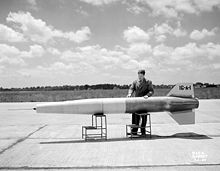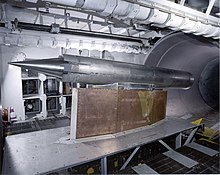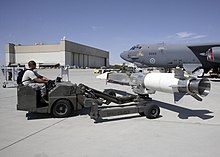Ramjet
A ramjet engine (engl. Ramjet as embodiments with supersonic combustion scramjet ) is an air-breathing jet engine , in which not the compression supplied to the combustion chamber air through moving parts such as compressor takes place, but simply by utilizing the high flow velocity of the gas itself in a stationary, closely nascent enema.
Ramjet engines can therefore not generate static thrust and only work from a minimum speed; depending on the exact design, often only at supersonic speed . For the start, ejectable auxiliary rockets ( boosters ) are mostly used.
Sometimes the deflagration jet engine is also incorrectly counted among the ramjet engines, which was used in the V1 among others . However, the design and function differ so much that this assignment does not seem sensible (no compression, functioning when stationary, intermittent operation).
Ramjets were already described by René Lorin at the beginning of the 20th century , but are still rare and have so far been used mainly in anti-aircraft missiles such as the Soviet 2K11 Krug and 2K12 Kub , the British Bloodhound and the US Bomarc , the air-to-air missile MBDA Meteor or the cruise missile Navaho practically used. The Russian anti-ship missiles SS-N-26 Strobile and hypersonic glide missiles Awangard also have such propulsion systems.
basis
The functional principle and the basic mechanical structure of these engines is very simple compared to gas turbine- based drives. However, mastering the aerodynamics at operating speeds (up to ten times the speed of sound) is demanding.
Basically, a jet engine gets its thrust from the combustion of fuel . For effective combustion, however, compression of the air supplied is necessary. At flight speeds in the subsonic range, a turbofan engine is mostly used nowadays , which uses a multi-stage axial compressor.
At higher flight speeds, however, the back-up effect of the engine results in a competing pressure increase, as a result of which the share of the axial compressor in the pressure development decreases. At Mach 1 it is around 50% each, until Mach 3 the proportion drops to around 0%. At several times the speed of sound, the efficiency of conventional gas turbine jet engines decreases while, on the other hand, the dynamic pressure already leads to sufficient air compression.
Ramjets are based on this principle, but they do not work at a standstill or at very low speeds, since there is no compression due to a lack of ram pressure. To achieve their operational speed, they must therefore always be accelerated by an auxiliary power unit or other means. Their optimum range of services usually begins where jet engines based on gas turbines leave their optimum.
The advantages over turbofan engines include their low weight, low wear and tear and the ability to use different fuels. Compared to rocket engines , the advantage is the lower weight of the overall system, since the oxidizer does not have to be carried along as fuel, but the oxygen in the air is used.
function
The ramjet engine consists essentially of a tube that is designed as a diffuser at the inlet opening . A cone , the diameter of which increases in the direction of the air flow, forms a constriction with the tube wall for the air flow and thus ensures, according to Bernoulli, an increase in the (relative) flow velocity, whereby the pressure increases and the air is compressed.
In the following combustion chamber, the diameter of the engine decreases again or at least remains constant. The air heated by the compression is supplied at this point with fuel, which ignites itself and causes the gas to expand. The hot gas then emerges to the rear, is accelerated by the nozzle and aligned as axially as possible in the direction of flow. This enables the thrust to be used at the front of the combustion chamber.
The compression required for effective combustion is usually only given from an air speed of around 1,000 km / h. Most ramjet engines only guarantee optimum running from twice the speed of sound (above Mach 2 or 2,400 km / h). However, there were also ramjet engines that could be started at around 320 km / h and then accelerate the aircraft.
Subsonic / supersonic
On the basis of the compression, a distinction can be made between two variants of ramjet engines:
Subsonic combustion
With the Ramjet, the air flowing in inside the engine is decelerated below the speed of sound (viewed from the reference system of the vehicle or engine; with regard to the surrounding air, the previously stationary air is accelerated in the direction of flight), followed by a subsonic combustion (subsonic in Reference system of the engine). In order to reduce the inflow velocity into the combustion chamber to subsonic and thus to increase the pressure, a diffuser with a divergent shape is arranged in the area of the engine inlet . The same air mass that the engine passes through in a time t is also expelled in time t . Here the speed of the medium increases when the pipe cross-section decreases: A Laval nozzle following the combustion chamber then accelerates the escaping gas back to supersonic. The working range of this type of engine is with hydrocarbons at flight speeds up to Mach 5; with hydrogen up to Mach 7.
This technology was first used in the 1950s on the Lockheed X-7 and the Nord 1500 Griffon .
Supersonic combustion in the scramjet
When scramjet ( S upersonic C ombustion Ramjet - Supersonic Combustion Ramjet- ) is braked during the compression is not (engine-related) below the speed of sound the incoming air and the combustion occurs as a supersonic combustion. The working range of scramjet engines is then between (aircraft-related) Mach 5 and (projected) Mach 15.
The density ρ of the gas is decisive for the gas acceleration: In contrast to the Laval nozzle of the Ramjet, an expansion of the nozzle diameter leads to an acceleration of the emerging medium. The reason for this is the free expansion of the medium, which means that greater expansion and thus a higher exit speed can be achieved.
Scramjet engines are flowed through at supersonic speed (> Mach 3) over their entire length and must be able to withstand the resulting significantly higher temperatures. For example, at a speed of Mach 8, depending on the air density, a temperature of 3000 to 4000 ° C arises . In the X-51 developed for Mach 6, the fuel flows around the engine, which is over 1000 ° C, to cool it and absorbs the heat, thereby evaporating. The cooling channels are coated with a catalyst and the fuel ( JP-7 ) is broken down into smaller (lighter) molecules, such as hydrogen or ethylene. These are then burned.
Another problem with supersonic combustion is the short dwell time of the air in the engine. This makes it harder for the fuel to mix with the air and the oxygen it contains. This problem can be solved by taking suitable measures in the engine design.
The scramjet also has an insulator , a piece of pipe with a constant cross-section, in order to prevent unwanted compression shocks and blockages at speeds above Mach 3.
Scramjet flights
The first detection of supersonic combustion in a missile was made by the HFL Cholod in November 1991 in Russia. The Scramjet was developed by the Central Institute for Aircraft Engines (ZIAM) in Moscow in the late 1970s. The theoretical basis for supersonic combustion emerged in the Soviet Union in the 1960s. From 1992 to 1998 another 6 test flights of the axially symmetrical scramjet demonstrator were carried out by ZIAM together with France and later with NASA . Maximum flight speeds of over Mach 6.4 were reached and the scramjet operation could be demonstrated for 77 seconds.
On March 26, 2004, the US American NASA reached seven times the speed of sound with the X-43A missile with the help of the scramjet drive and held it for a few seconds. The operational speed required for the scramjet engine was achieved by a Pegasus launcher.
On November 16, 2004, NASA reached just under Mach 10 with a similar test setup. The Pegasus launch vehicle with the X-43A was launched from a B-52 at a height of 12 km. The actual flight of the X-43A took just under 20 seconds to over 33 km altitude and reached Mach 9.8 (about 11,000 km / h or 3.05 km / s).
In 2007 the HyCAUSE ( Hypersonic Collaborative Australia / United States Experiment ) experimental missile reached Mach 10 over the Woomera test site in Australia.
In 2009, test flights in the HIFiRE ( Hypersonic International Flight Research Experimentation ) program continued.
The third test attempt by the US Air Force took place in 2012 : the X-51A experimental hypersonic aircraft operated with a scramjet engine . On August 14, 2012, the rocket engine ignited after being launched from a B-52 bomber. However, after 16 seconds problems arose and the missile spiraled out of control. On its fourth test flight on May 1, 2013, it reached a speed of Mach 5.1 and flew around 426 km in just over 6 minutes.
On January 9, 2014, US satellites observed an object flying at Mach 5 (according to unconfirmed data up to Mach 10) at an altitude of 100 km. In this case Mach 5 would mean about 5400 to 6000 km / h or Mach 10 about 11,000 km / h. According to American data, which were supported by Chinese data, it is a Chinese experimental unmanned glider with the not yet final name WU-14 . The aircraft, now known as DF-ZF , is said to have been brought to the height and speed required to ignite the scramjet in the first phase by a military long-range launcher.
Special forms

In the Pluto project , a nuclear ramjet was developed at great expense at the end of the 1950s , which was supposed to carry a number of H bombs into the USSR while flying low at Mach 3 . The engine was successfully tested in 1961, but the project was discontinued for political and practical reasons before flight tests began.
In the Lockheed SR-71 reconnaissance aircraft , Pratt & Whitney J58 engines are used, which, as variable-cycle engines, combine turbo and ramjet functions: At low speeds, only the turbojet function is used, from Mach 3 onwards Moving the inlet cone, part of the air flow past the turbines is used as a ramjet, at the top speed of Mach 3.2, 80% of the thrust is generated in this way.
The US corporations Pratt & Whitney and United Technologies have developed an engine as part of the FALCON program that enables both subsonic and supersonic combustion in a single engine. It can operate in the speed range from Mach 2.5 to Mach 6, with the last test being in September 2007.
See also
|
literature
|
Web links
- History, technology, diagrams and photos
- Ramjets: Development, Technology and Problems
- Development, technology and problems; Calculations (PDF; 1.3 MB)
- NASA: Ramjet / Scramjet Trust, (English) calculations, information
- ARLA ( Memento from September 21, 2008 in the Internet Archive )
- An early concept: the Rockwell Starraker Ramjet
- Aero-thermodynamic design of a scramjet propulsion system for future space transport systems, University of Stuttgart, accessed on February 9, 2019
Individual evidence
- ^ Glenn Olson: Ramjet Performance Primer. The 456th Fighter Interceptor Squadron, November 2, 2005, accessed on August 1, 2012 (English, "[…] the Leduc 0.10 was launched from atop a conventional airplane at 200 mph in order to operate the engine.").
- ↑ Deutschlandfunk: At hypersonic speed over the Pacific .
- ↑ Craig Covault: X-51 scramjet flights poised to bridge air and space propulsion for space launch, Prompt Global Strike . Spaceflight Now on May 16, 2010, accessed February 14, 2019.
- ↑ W. Pavlenko: Hypersonic Engines - A Soviet Analysis . In: Flug-Revue March 1968, pp. 34–36
- ↑ Scramjet hits Mach 10 over Australia newscientist.com.
- ↑ DARPA scramjet nudges Mach 10 theregister.co.uk.
- ↑ HyShot uq.edu.au
- ↑ Woomera hosts first HIFiRE hypersonic test flight dailytelegraph.com.au, accessed May 14, 2011.
- ↑ Report by Alexander Stirn in Süddeutsche Zeitung v. August 17, 2012, p. 16
- ↑ Werner Pluta: Experimental aircraft X-51A Waverider sets a record . Golem.de from May 6, 2013, accessed on February 14, 2019.
- ↑ Die Presse: China is testing hyperfast missile . Retrieved July 21, 2014.
- ↑ WantChinaTimes.com: PLA tests high-speed missile amid hypersonic arms race talk . Retrieved July 21, 2014.







